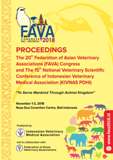IS-20 Atmospheric Science within a One Health Perspective
Abstract
In the atmosphere, particulate matters exist as aerosols which may have essential functions for the earth system to health quality of the individuals. A field of atmospheric sciences associated with aerosols has been focusing mainly on their chemical and physical properties to characterize their role and effect for the climate system, ocean-atmosphere interaction, health-related issue, and more.
It is well recognized that biological aerosols defined as “bioaerosols” to be present ubiquitously in the atmosphere, yet the scientific knowledge of their roles and functions are somewhat limited [1].
Since the bioaerosols may have a significant effect on climate, health quality of human and livestock animals, and ecological system, it is of great importance to acquire further knowledge in many aspects. The bioaerosols such as bacteria, virus fungi, and their fragments are not well in-cooperated with the atmospheric science researches mainly due to the difficulty associated with detection of bioaerosols. Often the concentration of bioaerosols in the air is very low, which requires sampling of a large air mass. Furthermore, the current scientific communities still lack the multidisciplinary approaches to tackle airborne infection, allergen dispersion, the stability of the biological material and more in the atmosphere.
Traditionally in both human and veterinary medical sciences, the bioaerosol investigations focused on understanding the infectivity of potential airborne infectious materials. For example, influenza, tuberculosis, mycoplasma, and other pathogenic ones to be examined. For example, the main focus points are finding strains which are more easily spread and the probability of infection to occur. Also, for the prevention of infectious diseases, understanding host susceptibility and immune response are also important focal points. However, in the real atmospheric condition, there are many substances in the air both gas and particulate phases. Thus understanding the mechanism of airborne infection requires not only the pathogen by itself, but it also needs to include some other co-existing airborne materials such as dust and air pollutants. Therefore, investigating the viability of bacteria with the effects of the particulate matters commonly found in the atmosphere as the co-existing material is important. Our research activities primarily focus on interactions between the bioaerosols and some other particulate matters such as dust and air pollutant in the atmosphere. This approach tries to evaluate the factors attributing the prolongation or reduction of the viability of bioaerosols. More specifically, understanding the critical factors to determine the viability of airborne pathogen, it may be easier to find solutions to control the airborne infection. Our work also focuses on emerging diseases such as Non-tuberculosis mycobacterium (NTM) clinical case in Japan [2].
In order to achieve global health, the one health approach can bridge the medical and environmental sciences as the multidisciplinary effort to safeguard human, animal, and environmental health.

